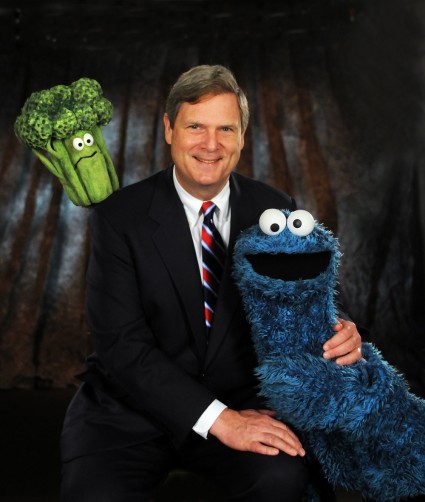In Meat Wagon, we round up the latest outrages from the meat and livestock industries.
——
 USDA chief Tom Vilsack, with special friends: Will this guy ever get serious about the swine flu/swine farm link? Why isn’t the federal government seriously investigating the possible CAFO-swine flu link?
USDA chief Tom Vilsack, with special friends: Will this guy ever get serious about the swine flu/swine farm link? Why isn’t the federal government seriously investigating the possible CAFO-swine flu link?
I’ve posed that question several times recently, most recently here. Now let me venture an answer.
The USDA is the federal agency tasked with ensuring that practices on farms, including factory animal farms, are safe. But it’s also the agency that exists to promote U.S. agricultural interests. In other words, the USDA has an inherent conflict around overseeing conditions on factory-style farms. For example, training a cold eye on the systemic safety hazards of factory farming isn’t likely to do much to promote the pork industry.
And from the start of the novel H1N1 outbreak, the USDA has tilted decidedly in the direction of promoting U.S. ag interests. Even though virologists and veterinary scientists have been warning for years that large hog farms create ideal conditions for the generation of dangerous new flu viruses–as this Environmental Health Perspectives article definitively shows—the USDA still isn’t systematically testing swine herds for H1N1. It continues to rely on a voluntary–and little used– testing program.
Nor is it doing much, from what I can tell, on the problem of MRSA, the antibiotic-resistent staph infection that claims more lives every year than AIDS. MRSA has been pretty definitively linked to factory hog farms–specifically the dubious practice of dosing pigs daily with antibiotics.
If the USDA has been limp in its attempts to examine safety conditions on factory farms, it’s been downright zealous in its efforts to promote the pork industry.
The latest: The USDA spent a cool $50 million on pork last week, in an explicit attempt to “assist … struggling producers.” That brings total 2009 federal spending on pork–the “other white meat,” that is, not pet projects for cronies–to $105 million. The latest $50 million worth of pork will be shunted into the National School Lunch Program, playing its traditional role of sinkhole for unwanted ag commodities.
Now, there are instances when the federal government should aid struggling producers by taking excess product of the market, and the school lunch program is a fine place to send high-quality products. At the same time it dropped $50 million on pork, the USDA spent another $32 million on cherry, plum and apple products, also destined for the school system. You won’t find me protesting that.
But let’s take a harder look at this year’s $105 million pork expenditure. As Elanor Starmer showed in an excellent post on Ethicurean, these USDA pork purchases don’t really amount to a bailout for hog farmers–who are indeed hurting from high feed prices and low hog prices–but rather for the pork-processing industry, which is dominated by multinational giants: Smithfield, Tyson, Cargill, and JBS.
I would argue that if the USDA wanted to help hog farmers, it would bust up the meat trusts, aid the remaining independent CAFO operators in scaling down their resource-sucking, pathogen-incubating, pollution-spewing operations and send their pigs out to pasture, and reinvest in processing infrastructure. By snapping up excess CAFO pork, it’s just handing a sop to Smithfield and its ilk.
Dithering on the swine flu threat while intervening in markets on behalf of the swine industry serves no one’s interests–except those of the shareholders in the meat-industry giants.
Smithfield’s shares jump
Meanwhile, those shareholders are starting to cash in. The problem of consolidation within the hog industry is only intensifying–the economic crisis is sending smaller industrial players to bankruptcy court, leaving the likes of Smithfield with yet more market share in the hog production space.
To understand what’s going on here, you have to know that Smthfield isn’t just the globe’s largest hog processor–i.e., it slaughters million of hogs every year and sells tons of pork. It’s also the globe’s largest hog producer–i.e., it raises hogs on large factory farms.
It processes many more hogs than it raises, so it also buys hogs from other producers, most often on contract.
This is the so-called vertical-integration strategy: With its own vast herd and its contracts, Smithfield controls the process of pork production from piglet to pork chop.
Right now, there’s a vast oversupply of hogs, depressing prices for both live hogs and pork. That means both of Smithfield’s business units are hurting. But as a large and relatively cash-rich player, smithfield can withstand the pain better than its small competitors–who are now dropping like fattened hogs in a slaughterhouse kill line.
From CBS Marketwatch:
North Carolina’s Coharie Hog Farm filed for Chapter 11 bankruptcy protection on Nov. 6, joining fellow state producer Coastal Plains Pork, which sought bankruptcy protection Sept. 28, and Bunting Swine Farms LLC this past May.
Also recently, Minnesota’s MHF of Freeborn County Inc. declared Chapter 11 in October while Illinois-based Leading Edge Pork LLC filed for bankruptcy protection in September.
More could unfold. According to Stephens’ analysis, two of the nation’s top 25 pork producers are “on the brink of bankruptcy.”
As these smaller players fall away, they liquidate their herds–meaning fewer hogs on the market, and higher hog prices down the road. And the surviving players like Smithfield benefit. And that, in a nutshell, is why Smithfield shares jumped 20 percent last week. The small fry fall away, and the big abide. Or to use a wonderful Biblical phrase highlighted by the great Flannery O’Connor, “the violent bear it away.”
Supersize me
Vibrant ecosystems thrive on diversity–lots of different varieties of critters provide a broad genetic base, bringing resilience in times of flux or shock.
The meat industry, by contrast, likes monocultures. It settles on just a few varieties of, say, chickens, and then aggressively breeds them for certain traits: mainly, the ability to fatten quickly on grain-heavy diets.
Cloning technology brings that dubious principle to its logical extreme: It takes the thin genetic band on which modern agriculture rests and reduces it to a microscopic line. Rather than endure the small random fluctuations of conventional breeding, livestock producers can now experience the precision of the Xerox machine.
The technology remains in its infancy–so much so that it costs $15,000 to clone a cow, reports Reuters in a recent article called “Welcome to the Clone Farm.” But didn’t stop the FDA from approving meat from cloned animals for human use last year. The agency invoked the same principle it used in the 1980s to wave through GMOs from the lab to the plate: “substantial equivalence.” As Reuters puts it, the FDA ruled that “the products are indistinguishable from that of their non-clone counterparts.”
While the expense is holding down adoption of cloning as a breeding strategy, the technology is very much in use. According to Reuters, “[C]onsumers are likely already eating meat and drinking milk from the offspring of clones, which are technically not clones, without even knowing it.” Oh, yeah–did I mention that the FDA decided against requiring that meat from cloned animals be labeled?
Toward the end of the article, we find information that makes the “substantial equivalence” principle look really, really shaky for cloned meat. Let me ask you this: does conventional animal breeding regularly result in “large offspring syndrome”?
Here’s Reuters:
Despite cloning’s gradually improving rate of success in producing healthy animals, the process still has a high rate of failure. Some animals are born with abnormalities and have to be euthanized and some have more health problems at birth than conventionally bred animals.
Large Offspring Syndrome also occurs more often with assisted breeding technologies like cloning. The syndrome causes the fetus to grow too large, causing problems for both the clone and the surrogate.
Currently, cloning technologies produce an (apparently) healthy animal in just 10-15 percent of attempts–and the rest of the time produce grotesquely flawed creatures that must be killed immediately.
Sounds like a technology that could use a bit more study–long-term, multi-generational studies, to be exact. Does saying so make me guilty of rank “denialism“?


